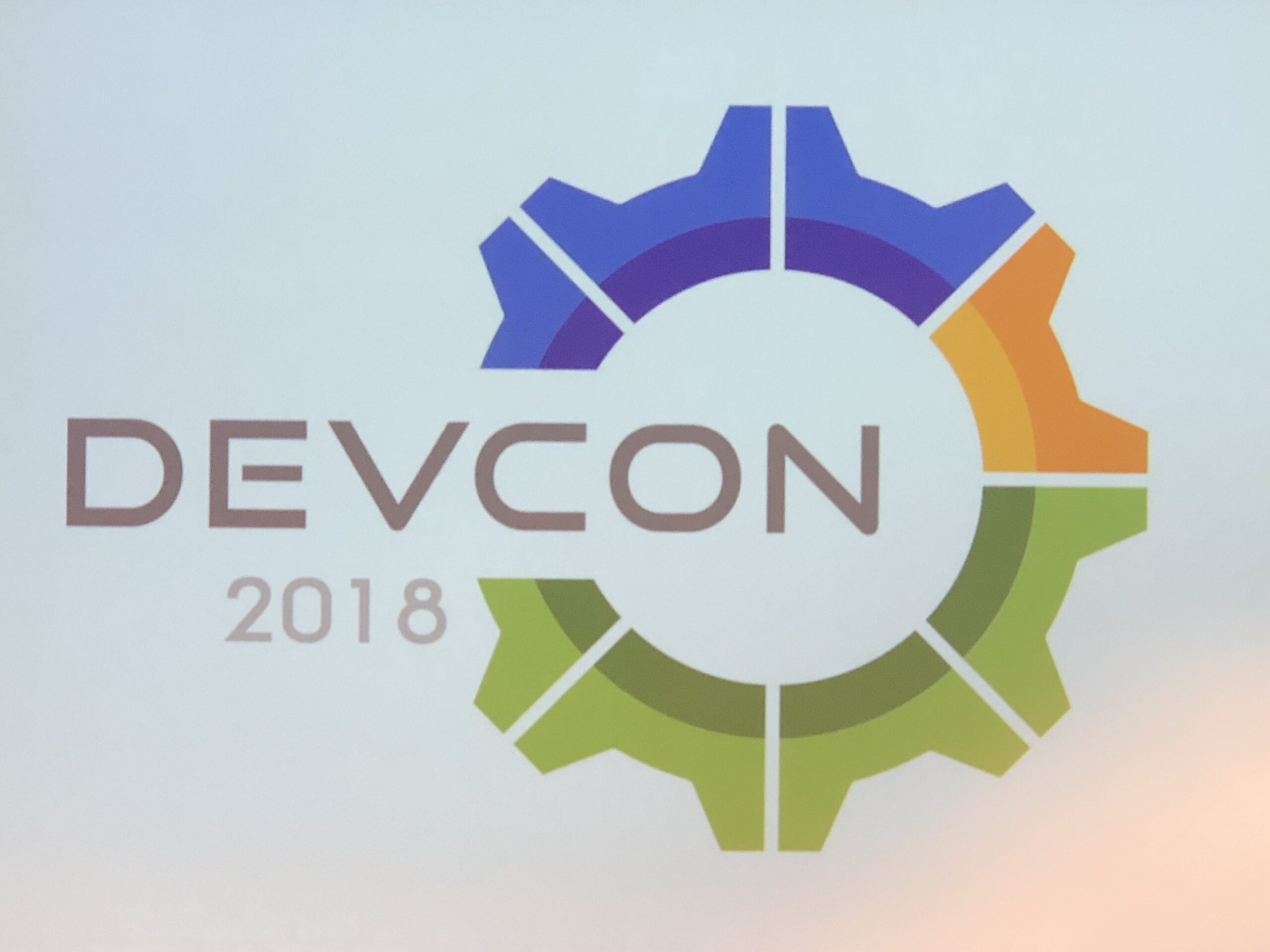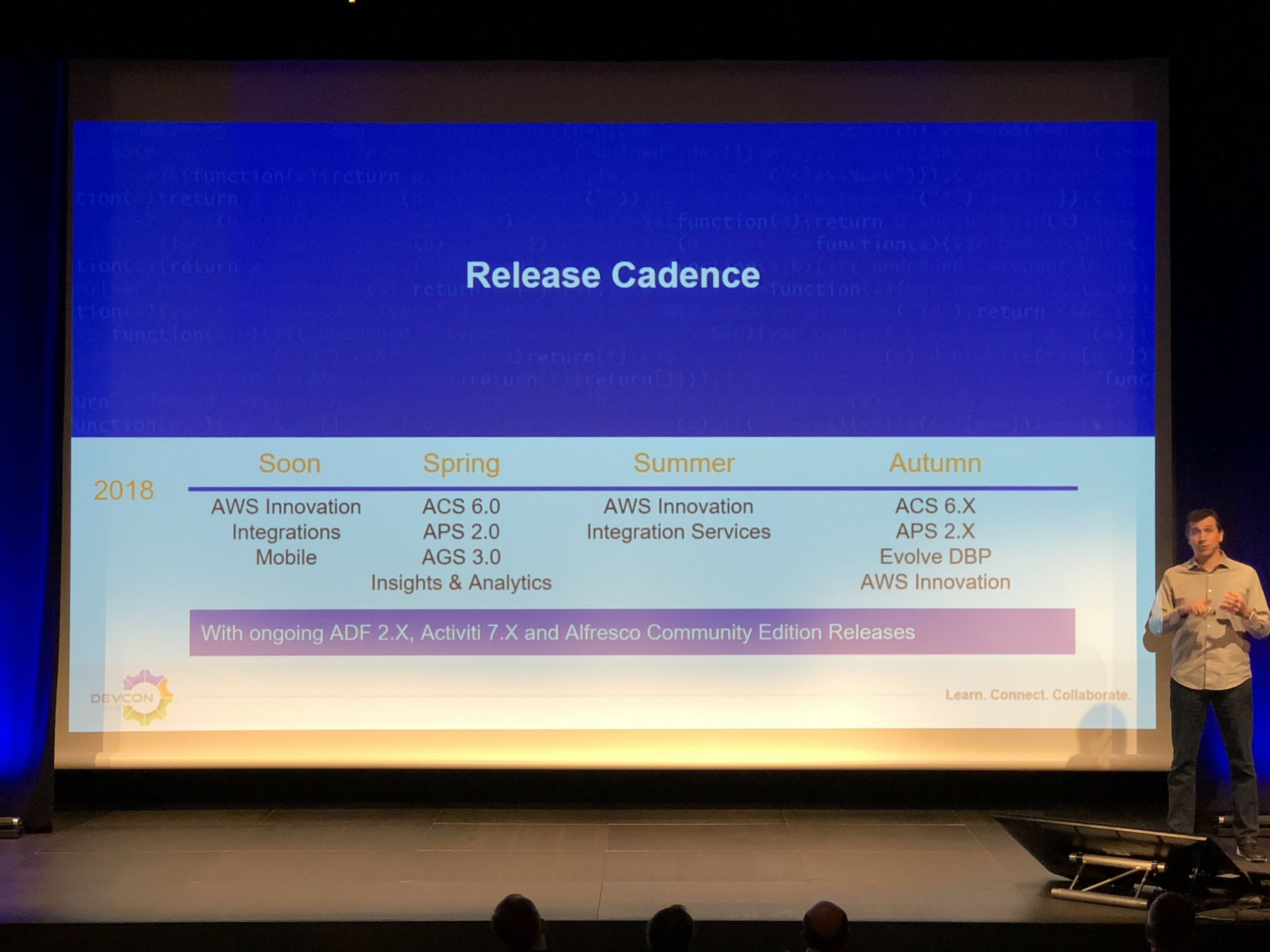Here we are, the Alfresco DevCon 2018 day-1 is over (well except for the social party)! It’s been already 2 years I attended my last Alfresco event (BeeCon 2016, first of its name (organized by the Order of the Bee)) because I wasn’t able to attend the second BeeCon (2017) since it happened on the exact dates of our internal dbi xChange event. Yesterday was the DevCon 2018 day-0 with the Hack-a-thon, the full day training and the ACSCE/APSCE Certification preparation but today was really the first day of sessions.
The day-1 started, as usual, with a Keynote from Thomas DeMeo which presented interesting information regarding the global direction of Alfresco products, the Roadmap (of course) for the coming year as well as some use cases where Alfresco was successfully used in very interesting projects including also AWS.
The second part of the keynote has been presented by Brian Remmington which explained the future of the Alfresco Digital Platform. In the next coming months/years, Alfresco will include/refactor/work on the following points for its Digital Platform:
- Improve SSO solutions. Kerberos is already working very well with Alfresco but they intend to also add SAML2, OAuth, aso… This is a very good thing!
- Merging the Identity management for the ACS and APS into one single unit
- Adding an API Gateway in front of ACS and APS to always talk to the same component and targeting in the background both the ACS and APS. It will also allow Alfresco to change the backend APIs, if needed (to align them for example), without the API Gateway noticing it. This is a very good thing too from a developer perspective since you will be sure that your code will not break if Alfresco rename something for example!
- Merging the search on the ACS and APS into one single search index
- We already knew it but it was confirmed that Alfresco [will probably drop the default installer and instead] will provide docker/kubernetes means for you to deploy Alfresco easily and quickly using these new technologies
- Finishing the merge/refactor of other ACS/APS services into common units for both products so that work done once isn’t duplicated. This will concern the Search (Insight?) Service, the Transformation Service, the Form Service and a new Function Service (basically code functions shared between ACS and APS!).
All this looks promising, like really.
Then starting at 10am, there were four streams running in parallel so there is something that you will find interesting, that’s for sure. I didn’t mention it but DevCon isn’t just a name… It means that the sessions are really technical, we are far from the (boring) Business presentations that you can find on all other competitors’ events… I did a full morning on ADF. Mario Romano and Ole Hejlskov were presenting ADF Basics and Beyond.
For those of you who don’t know yet, ADF (Alfresco Development Framework) is the last piece of the Digital Platform that Alfresco has been bringing recently. It is a very interesting new framework that allows you to create your own UI to use in front of the ACS/APS. There are at the moment more than 100 angular components that you can use, extend, compose and configure to build the UI that will match your use case. Alfresco Share still provide way more features than ADF but I must say that I’m pretty impressed by what you can achieve in ADF with very little: it looks like it is going in the right direction.
ADF 2.0 has been released recently (November 2017) and it is based on three main pillars: the latest version of Angular 5, a powerful JavaScript API (that talk in the background with the ACS/APS/AGS APIs) and the Yeoman generator+Angular CLI for fast deployments.
ADF provides 3 extensions points for you to customize a component:
- html extension points => adding html to customize the look&feel or the behavior
- event listeners => adding behaviors on events for example
- config properties => each component has properties that will customize it
One of the goal of ADF is the ability to upgrade your application without any efforts. Angular components will be updated in the future but it was designed (and Alfresco effort is going) in a way that even if you use these components in your ADF application, then an upgrade of your application won’t hurt at all. If you want to lean more about ADF, then I suggest you the Alfresco Tech Talk Live that took place in December as well as the Alfresco Office Hours.
After this first introduction session to ADF, Eugenio Romano went deeper and showed how to play with ADF 2.0: installing it, deploying a first application and then customizing the main pieces like the theme, the document list, the actions, the search, aso… There were some really interesting examples and I’m really looking forward seeing the tutorials and documentations popping up on the Alfresco Website about these ADF 2.0 new features and components.
To conclude the morning, Denys Vuika presented a session about how to use and Extend the Alfresco Content App (ACA). The ACA is the new ADF 2.0 application provided by Alfresco. It is a demo/sample application whose purpose is to be lightweight so it is as fast as possible. You can then customize it as you want, play with the ADF so that this sample application match your needs. One of the demo Denys presented is how you can change the default previewer for certain type of files (.txt, .js, .xml for example). In ADF, that’s like 5 lines of code (of course you need to have another previewer of your own but that’s not ADF stuff) and then he had an awesome preview for .js files where there were syntax highlighting right inside the Alfresco preview as well as tooltips on names to give description of variables and functions apparently. This kind of small features but done so easily look quite promising.
I already wrote a lot on ADF today so I will stop my blog here but I did attend a lot of other very interesting sessions on the afternoon. I might talk about that tomorrow.


![Thumbnail [60x60]](https://www.dbi-services.com/blog/wp-content/uploads/2022/08/MOP_web-min-scaled.jpg)
![Thumbnail [90x90]](https://www.dbi-services.com/blog/wp-content/uploads/2022/08/OLS_web-min-scaled.jpg)
![Thumbnail [90x90]](https://www.dbi-services.com/blog/wp-content/uploads/2022/08/GME_web-min-scaled.jpg)